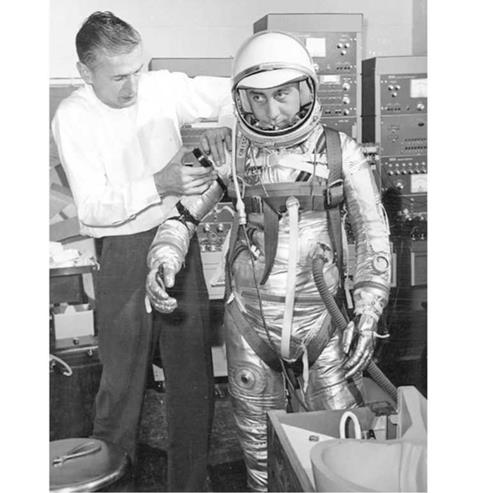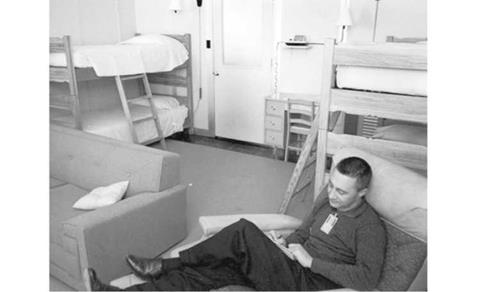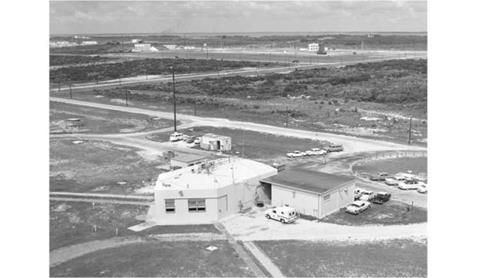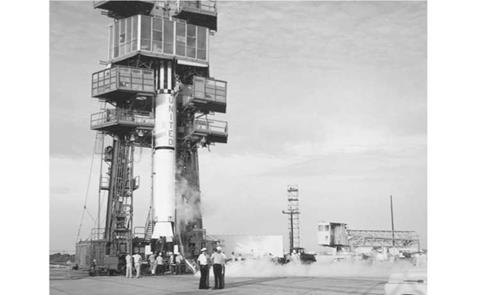READY TO GO
Three days before the planned MR-4 launch, Grissom participated in a mission dry run on Launch Pad 5. By this time he had moved out of the Holiday Inn in Cocoa Beach and was staying full-time in crew quarters at Hangar S. The simulated flight involved securing the side hatch, purging the crew cabin with oxygen, and rolling the launch gantry away.
“I showed up early at Pad 5 for the simulated flight which would be the final practice mission in the capsule before the launch,” he recalled. “It went fairly well, but I was kept so busy handling communications checks that I fell slightly behind in the count. All of the sequences in the countdown took place in the right order, but some of them came off a little late. Then the second of the three retro-rockets, which are programmed to fire at 5-second intervals, went off two and a half seconds early. So we had to check into that.”19
|
Joe Schmitt suits up Grissom for the simulated flight on 16 July. (Photo: NASA) |
Apart from these problems, the test was successfully completed and everything seemed to be in order for the actual launch.
On Sunday, 16 July – a day described by Grissom as “a fairly lazy day” – he and Glenn entered the final phase of preparation for Tuesday morning’s expected space shot. For the three days before the planned launch date they both lived in the crew quarters of Hangar S, where they had a comfortable bed, a television set and radio, reading material and complete privacy. It also provided them with isolation from any possible carriers of infectious disease organisms.
|
Grissom relaxes in the astronauts’ crew quarters in Hangar S. (Photo: NASA) |
The previous day, the two astronauts had begun a low-residue, high-energy diet to reduce the possibility of excretion and provide quick-burning reserve strength during the flight. They ate in a special ready room at the Cape, their meals being made by a personal chef whose sole duty during that time was to prepare their food. According to the astronauts’ flight surgeon Dr. William Douglas, the menu was prepared “by Miss Beatrice Finklestein of the Aeromedical Medical Laboratory, Aeronautical Systems Division, U. S. Air Force Systems Command.” As Dr. Douglas recorded, the chef prepared identical meals at each feeding; two went to the pilot and backup pilot, while several were given to other people “so that an epidemiological study can be facilitated if necessary.” An extra serving was kept in a refrigerator for 24 hours “for study in the event that the pilot develops a gastrointestinal illness during this period or subsequently.” Furthermore, no coffee was permitted during the 24-hour period preceding either suborbital flight because of its tendency to inhibit sleep, and none was permitted for breakfast on launch day because of its diuretic properties.20
For Grissom and Glenn, breakfast consisted of four ounces of strained orange juice, half a cup of cooked Cream of Wheat hot cereal, two or three slices of crisp Canadian bacon, two scrambled or boiled eggs, white toast, butter and strawberry jelly. For lunch they had broiled chicken, baby-food type peas, bread without crust, cottage cheese salad, ice tea, and sugar cookies. Dinner was broiled potato without skin, baby food vegetable and sherbet.
On Sunday afternoon the two astronauts traveled to nearby Patrick AFB to begin their final preflight physical examinations, following which Grissom relaxed with a little surf casting on the beach of the Cape missile center.
|
The Pad 5 blockhouse at Cape Canaveral. (Photo: NASA) |
|
A rocket stands ready to fly. (Photo: NASA) |
On Monday, 17 July, NASA announced that everything – including the weather – appeared to be set for the space shot. Lt. Col. John A. (‘Shorty’) Powers of NASA’s Public Affairs Office informed newsmen, “As of this time all elements are ‘A-OK’ for this mission.” The first use of the term ‘A-OK’ was once mistakenly accredited to Alan Shepard but it was actually Powers who introduced the phrase to the public, using it during his live broadcast of Shepard’s flight. Powers was a decorated former transport pilot who flew in World War II and Korea before serving as an information officer for the Air Research Development Command. He became the public face of NASA and the Mercury program and quickly earned for himself the sobriquet “the voice of the astronauts.” He knew that NASA engineers used the ‘A-OK’ term in radio transmissions tests because the sharper sound of the letter A cut through static better than the letter O. Liking the military snap of the phrase, Powers borrowed it for his mission broadcasts.
Powers also confirmed before an audience of 200 newspaper, radio and television reporters that Grissom remained the prime pilot for the MR-4 flight, with Glenn as his backup. He added that Shepard would be CapCom for the flight, backed up by Scott Carpenter. Slayton would be at the communications post in the blockhouse, maintaining radio contact with Grissom in the capsule before the launch. Schirra would be Slayton’s backup for this role. Gordon Cooper would observe the launch while flying high over the Cape in an F-106 jet.
Grissom and Glenn were asked to go to bed early on the evening before launch, but only as a suggestion, not a strict recommendation. As well, and unlike Shepard, Grissom would optimize his launch morning routine by shaving and bathing before retiring. By 5:00 p. m. on Monday afternoon he was fast asleep in crew quarters. At 10:30 he was woken by Bill Douglas and informed that the launch had been called off owing to low-hanging clouds spawned by a Caribbean weather front. Grissom, whose ability to relax under pressure helped him win MR-4, accepted this news with a yawn and went back to sleep.
Fortunately the Redstone rocket had not been loaded with liquid oxygen. This meant officials could reset the shot for the same time Wednesday without having to purge out the rocket. According to a NASA spokesman, it also meant that the first segment of the 12 hour-long countdown, which was completed Monday, would not have to be repeated. “It’s locked up,” the spokesman said, adding that the remaining hours of the countdown procedure would be picked up starting about 11:30 that evening.














